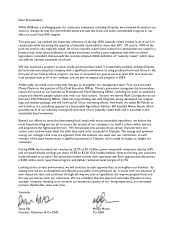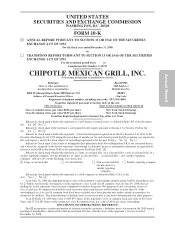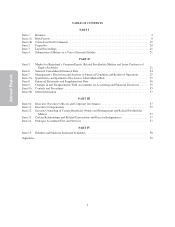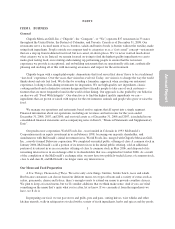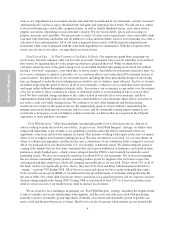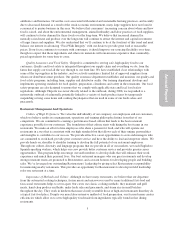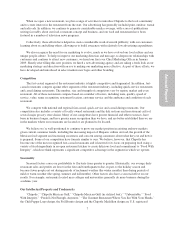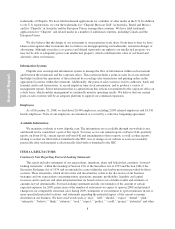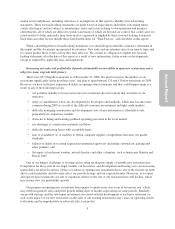Chipotle 2008 Annual Report Download - page 12
Download and view the complete annual report
Please find page 12 of the 2008 Chipotle annual report below. You can navigate through the pages in the report by either clicking on the pages listed below, or by using the keyword search tool below to find specific information within the annual report.
Our sales and profit growth could be adversely affected if comparable restaurant sales are less than we
expect.
While future sales growth will depend substantially on our plans for new restaurant openings, the level of
comparable restaurant sales (which represent the change in period-over-period sales for restaurants beginning in
their 13th full month of operations) will also affect our sales growth and will continue to be a critical factor
affecting profit growth. This is because the profit margin on comparable restaurant sales is generally higher, as
comparable restaurant sales increases enable fixed costs to be spread over a higher sales base. Comparable
restaurant sales increases decelerated during 2008, and we do not expect comparable restaurant sales growth to
continue at historical levels. We expect comparable restaurant sales increases in 2009 to be in the low single
digits due to the impact of weaker consumer spending as a result of the economic downturn, potential traffic
declines as a result of our recent menu price increases and difficult prior-year comparisons. If the economy
remains weak or further weakens, we may lower our expectations for comparable restaurant sales. In addition,
our ability to increase comparable restaurant sales depends in part on our ability to successfully implement a new
marketing and branding strategy, our initiative to increase the speed at which our crew serves each customer, and
expanded use of fax service lines and online ordering, each of which we may not be able to accomplish. As a
result of these factors it is possible that we will not achieve our targeted comparable restaurant sales growth or
that the change in comparable restaurant sales could be negative. If this were to happen, sales and profit growth
would be adversely affected and our stock price would be likely to decline.
New restaurants, once opened, may not be profitable, and the increases in average restaurant sales and
comparable restaurant sales that we have experienced in the past may not be indicative of future results.
Historically, many of our new restaurants have opened with an initial ramp-up period typically lasting
24 months or more, during which they generated sales and income below the levels at which we expect them to
normalize. This is in part due to the time it takes to build a customer base in a new area, higher fixed costs
relating to increased occupancy costs and other start-up inefficiencies that are typical of new restaurants. New
restaurants may not have similar results as our existing restaurants and may not be profitable. In addition, our
average restaurant sales and comparable restaurant sales likely will not continue to increase at the rates achieved
over the past several years and may decline, particularly due to the current economic downturn. Our ability to
operate new restaurants profitably and increase average restaurant sales and comparable restaurant sales will
depend on many factors, some of which are beyond our control, including:
• changes in consumer preferences and discretionary spending, including weaker consumer spending in
difficult economic times;
• other impacts of changes in general economic conditions, which can affect local labor costs and prices
we pay for the ingredients and other supplies we use;
• competition, either from our competitors in the restaurant industry, or from our own restaurants as
some customers who frequent one of our restaurants may begin to visit one of our new restaurants
instead;
• consumer understanding and acceptance of the Chipotle experience, which we intend to improve
during 2009 with a new branding and marketing strategy that has not been tested;
• executing our strategies effectively;
• initial sales performance of new restaurants;
• road construction, weather and other factors limiting access to new restaurants; and
• changes in government regulation.
If we fail to open restaurants as quickly as planned or if new restaurants do not perform as planned, our
business and future prospects could be harmed. In addition, changes in our average restaurant sales or
comparable restaurant sales could cause our operating results to vary adversely from expectations, which could
cause the price of our common stock to decline.
10
Annual Report


